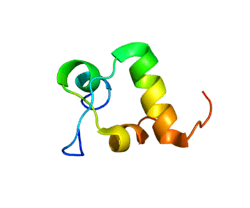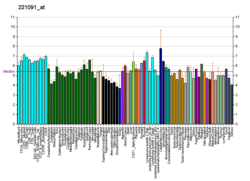Insulin-like peptide INSL5 is a protein that in humans is encoded by the INSL5 gene.[5][6]
Function
The protein encoded by this gene contains a classical signature of the insulin superfamily and is highly similar to relaxin 3 (RLN3/INSL7).[6]
Further reading
- Liu C, Kuei C, Sutton S, Chen J, Bonaventure P, Wu J, Nepomuceno D, Kamme F, Tran DT, Zhu J, Wilkinson T, Bathgate R, Eriste E, Sillard R, Lovenberg TW (January 2005). "INSL5 is a high affinity specific agonist for GPCR142 (GPR100)". The Journal of Biological Chemistry. 280 (1): 292–300. doi:10.1074/jbc.M409916200. PMID 15525639.
- Zhang Z, Henzel WJ (October 2004). "Signal peptide prediction based on analysis of experimentally verified cleavage sites". Protein Science. 13 (10): 2819–24. doi:10.1110/ps.04682504. PMC 2286551. PMID 15340161.
- Clark HF, Gurney AL, Abaya E, Baker K, Baldwin D, Brush J, Chen J, Chow B, Chui C, Crowley C, Currell B, Deuel B, Dowd P, Eaton D, Foster J, Grimaldi C, Gu Q, Hass PE, Heldens S, Huang A, Kim HS, Klimowski L, Jin Y, Johnson S, Lee J, Lewis L, Liao D, Mark M, Robbie E, Sanchez C, Schoenfeld J, Seshagiri S, Simmons L, Singh J, Smith V, Stinson J, Vagts A, Vandlen R, Watanabe C, Wieand D, Woods K, Xie MH, Yansura D, Yi S, Yu G, Yuan J, Zhang M, Zhang Z, Goddard A, Wood WI, Godowski P, Gray A (October 2003). "The secreted protein discovery initiative (SPDI), a large-scale effort to identify novel human secreted and transmembrane proteins: a bioinformatics assessment". Genome Research. 13 (10): 2265–70. doi:10.1101/gr.1293003. PMC 403697. PMID 12975309.
- Koman A, Cazaubon S, Couraud PO, Ullrich A, Strosberg AD (August 1996). "Molecular characterization and in vitro biological activity of placentin, a new member of the insulin gene family". The Journal of Biological Chemistry. 271 (34): 20238–41. doi:10.1074/jbc.271.34.20238. PMID 8702754.





